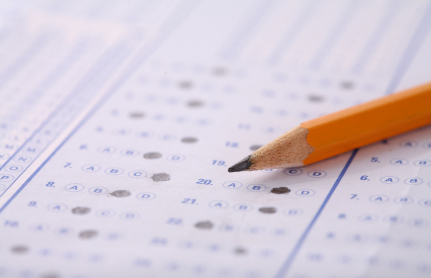Intention:
- Minimize light trespass from building and site
- Reduce sky glow
- Improve nighttime visibility through glare reduction
- Reduce development impact on nocturnal environments
Implementation:
- 4 Light Zones
- LZ1: dark, density less than 200 people per square mile
- LZ2: low (residential)
- LZ3: medium (commercial, industrial and high-density residential)
- LZ4: high major city centers, entertainment districts)
- Interior Lighting:
- stays inside
- non-emergency lighs shut down at non-business hours
- Exterior Lighting:
- provide for comfort and safety only
- DO NOT exceed 80% of lighting power densities for exterior area and 50% for building facades and landscape features as defined in ASHRAE/IESNA Standard 90.1-2004.
- DO NOT install lighting more than 2.5 times building height from property line
- Credit does not apply to 3 story buildings, warehouses, and manufactured homes.
Codes/Standards Applied:
- ASHRAE/IESNA 90.1.2004
- ANSI
- California Energy Code Title 24
Extra Credit:
- none
Submittal Phase:
- design
Links from Reference Guide:
- American Society of Heating Refrigeration and Air-Conditioning Engineers
- Illuminating Engineering Society of North America
- International Dark-Sky Association
Other Sustainable Sites Credits
- SS P1 – Construction Activity Pollution Prevention (prerequisite)
- SS 1 – Site Selection
- SS 2 – Development Density & Community Connectivity
- SS 3 – Brownfield Redevelopment
- SS 4.1 – Alternative Transportation – Public Transportation Access
- SS 4.2 – Alternative Transportation -Bicycle Storage & Changing Rooms
- SS 4.3 – Alternative Transportation – Low Emission & Fuel Efficient Vehicles
- SS 4.4 – Alternative Transportation – Parking Capacity
- SS 5.1 – Site Development – Protect or Restore Habitat
- SS 5.2 – Site Development – Maximize Open Space
- SS 6.1 – Stormwater Design – Quantity Control
- SS 6.2 – Stormwater Design – Quality Control
- SS 7.1 – Heat Island Effect – Non-Roof
- SS 7.2 – Heat Island Effect – Roof
- SS 8 – Light Pollution Reduction







34 Comments On This Post
What does this meaning?
Plz explain.
DO NOT install lighting more than 2.5 times building height from property line.
From a fixture at 2.5x mounting height distance from property line, no light must fall beyond property line.
Steve,
Do you mean
Max.E.Lighting = 2.5 X bldg. ht
No!
Not building height
The light fixture height
ie. imagine taking a measuring tape and measure from the light pole a distance equal 2.5 times the height of fixure from the ground. If at the measured dsitance you are anywhere in the neighboring property, there should no light from the fixture in question. –
-the intent no light tresspassing onto neighbor’s land.
therefore use cut-off shield to control glare or leakage to the neighboring property.
Caveat: I am studying for the Canadian CGBC exam based on USGBC NC2.2. Initial version of the NC SSCr8 made mention of the 2.5 times fixture height from property line. The latest CGBC 1.0 with Addendum amended the whole text with LZ1,2,3&4 zones AS PER IESNA RP-33.
Verify your latest NC 2.2
In the light pollution reduction it notes that “Credit does not apply to 3 story buildings, warehouses, and manufactured homes”.
Is it three stories or taller?
It is 3 stories or less- In credit 8
if you mean in the Reference Standard Ashrae/Iesna Standard 90.1 2004…in the summary says:
“The provisions of this standard do not apply to single family houses, multifamily structures of three habitable stories or fewer…….manufactured houses, buildings that do not use electricity or fossil fuel……and …buildings ..that use energy primarily for industrial,manufacturing, or commercial processes.”
The facade lighting (Lighting Power Density) in our project does not comply with ASHRAE requirement which is 0.2 watt/Sqft. However we are complying with 5 watt/linear foot as mentioned in Table 1 Page 104 of the Reference guide book. Taking into consideration that facade light is LED lights. Is there any special requirement for taking the second compliance path?
One more thing to meet the mandatory credit minimum energy saving for New construction (14%, do we have to reduce in all interior and exterior Lighting power densities by 14% of ASHRAE requirement or we just need to meet the ASHRAE requirement
Regards
Abdelgader
“DO NOT install lighting more than 2.5 times building height from property line” is actually a very confusing statement. It sounds like I should keep my lighting at the perimeter of the property. I initially thought it meant within a (2.5x Height of building) perimeter of the building… which I thought made sense before I was reading the comments 0_o Steve- from this site it appears to reference the bldg height specifically, not the fixture.
Is the actual wording much clearer; I have yet to move past this website to the handbook/real terminology.
Ref. Guide 2.2, p. 109 gives a table (Calculation 1). How did they calculate Actual LPD Reduction (%)? I would think one would divide the difference between Allowable LPD and Actual LPD by the Allowable LPD. So for Parking 1 the equation would be: (0.25-0.11)/0.25 = 0.56 = 56%. Using the same method Parking 2 would be 26.67% (27% rounded). Walkways 1 would be 20%, Courtyard 1 = 20%, Building Facade N = 50%.
Any thoughts?
Gary
I think “Parking 1” is just wrong, and/or they’ve put in more-or-less random answers in the “Actual LPD Reduction” column. Not very helpful of them.
I hope the folks who publish the errata for the guide are looking at this website…
Thanks Melissa.
Gary
Regarding the “2.5 times fixture height”-I’ve been cross referencing this site and the LEEDPASS study guide by Shawn Shahfar and there he states this as “At property line locate the lighting at ZERO elevation. The elevation of a fixture should be equal or less than 2.5 times of its horizontal distance to the property line.” Hope this helps others, it made a lot more sense to me.
I do not see this 2.5 building height/light fixture issue called out anywhere in my ref. guide, v2.2 September 2006.
From LEED NC V2.2, October 2007 – SSc8, page 108, col. 2 under Item 8 it reads,
“Where luminaires are within 2.5 times their mounting height from the project boundary and the light levels are not zero at the boundary, light trespass is more likely to be a problem.”
2.5 times height (vertical distance) from the project boundary (horizontal distance), sounds more like a ratio to me. If it is within this zone the light level should be zero at the boundary. The intention is to reduce the light pollution so it reads like the lower the light fitting the less upward illumination spills out. Provided that the illumination for that zone (LZ) is appropriate and does not leak out of the site boundary.
so, the ideal fixture (according to this credit) would be at least 2.5x its height away from the property line, right?
Can anyone tell me the LEEDs code for secure room doors. We will have computers, video projectors, and other equipment in this room. Do they have to have windows to have the building LEEDs Certified? We are having a building built and the archetecs are telling me that all room doors must have a window. In our case it has 3 doors with 18.5″ x 40″ windows in the doors.
would like to clarify LEED SSc8: light pollution reduction for site boundary Foot-candle calculation. For this calculation I am using DIALUX 4.6 software. Is this possible to comply LEED SSc8.Becoz this software doesn’t show the site plan and outside boundary how much Foot candle .Please Kindly send me any software details for this calculation.
would like to clarify LEED SSc8: light pollution reduction for site boundary Foot-candle calculation. For this calculation I am using DIALUX 4.6 software. Is this possible to comply LEED SSc8.Becoz this software doesn’t show the site plan and outside boundary how much Foot candle .
I am currently working on a condo building in Cincinnati, Ohio and we are seeking LEED Certification. We have floor to ceiling windows in all living spaces and windows from 3′ aff to 9′-4″ (our ceiling height) in the bedrooms. We are all confused on the interior portion of this point…we have an individual who has purchased a condo and wants to use track lighting, the track heads can angle parallel to floor and spin in a 360 degree circle. Therefore the maximum candela of the track fixture could theoretically shine out the window. Although the track lighting is for illuminating art work on walls and sculptures that will be placed throughout the unit. Would this still not be accepted since at the worst case scenario of the track head it will shine out the window? And help would be appreciated! We have been contemplating this back and forth in our office for weeks. THanks in advance!
Cathy, that sounds tricky. Maybe there is a relevant CIR?
Is the LEED AP test open book? I have heard both yes and no.
Don’t believe so Gary, get memorizing obscure figures and standards…
SS8 What are post-curfew periods? After hours or after 10.00pm? Until dawn?
Do we need to memorize the the ASHRAE table in the section (SSc8)..???
Jessie: After hours = after 10 p.m..
I have also seen in practice test answers and the Colorado Study Guide a standard is IESNA RP-33.
Y<=2.5X
WHERE
Y IS THE HEIGHT OF LIGHT FIXTURE.
X IS HORIZONTAL DISTANCE FROM FIXTURE TO BLDG.
IM SO CONFUSED, PLEASE HELP
Y<=2.5X
WHERE
Y IS THE HEIGHT OF LIGHT FIXTURE.
X IS HORIZONTAL DISTANCE FROM FIXTURE TO BLDG.
IM SO CONFUSED, PLEASE HELP!
SSc8 light pollution reduction.
H >= 2.2 *(D) THIS MEANS
H-MOUNTING HEIGHT OF THE LIGHT
D-DISTANCE BETWEEN THE PROJECT BOUNDARY LINE AND POLE LOCATION.
IF H >= 2. * (D) THEN FIXTURES MUST BE SHEILDED(HOUSE SIDE SHIELD)
“Credit does not apply to 3 story buildings, warehouses, and manufactured homes”…
where is this in ref guide??
Nd do we need to memorize the ASHRAE table??
dt:
is in page 105 of v2.2 guide
I ran across a question on some flash cards that has me a bit puzzled. It is:
What are two effective strategies for reducing light pollution?
A Utilize shielded luminaires
B Increase the pole height of parking lot fixtures
C Use a curfew timer to control ornamental lights
D Avoid fixture aiming angles greater than 90 degrees above vertical.
The answer they have is C and D.
I would have thought A and D because the C option is only ornamental lights, whereas the A option could cover all lights, and assuming ornamental lights were smaller. But why would A not be a good answer?
In working on a project, I have had some questions regarding SSc8. Does anyone understand the difference between tradable surfaces and non-tradable surfaces? What’s the point in defining the Lighting Power Density for each of the tradable surfaces?
If a parking area can have the same LPD as a canopy, (0.15W/ft2 and 1.25W/ft2, respectively) why isn’t there just a maximum LPD for all tradable surfaces?
Or do I have this wrong?